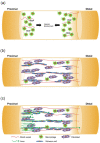Acellular Nerve Allografts in Major Peripheral Nerve Repairs: An Analysis of Cases Presenting With Limited Recovery
- PMID: 33880944
- PMCID: PMC10035101
- DOI: 10.1177/15589447211003175
Acellular Nerve Allografts in Major Peripheral Nerve Repairs: An Analysis of Cases Presenting With Limited Recovery
Abstract
Background: Acellular nerve allografts have been used successfully and with increasing frequency to reconstruct nerve injuries. As their use has been expanded to treat longer gap, larger diameter nerve injuries, some failed cases have been reported. We present the histomorphometry of 5 such cases illustrating these limitations and review the current literature of acellular nerve allografts.
Methods: Between 2014 and 2019, 5 patients with iatrogenic nerve injuries to the median or ulnar nerve reconstructed with an AxoGen AVANCE nerve allograft at an outside hospital were treated in our center with allograft excision and alternative reconstruction. These patients had no clinical or electrophysiological evidence of recovery, and allograft specimens at the time of surgery were sent for histomorphological examination.
Results: Three patients with a median and 2 with ulnar nerve injury were included. Histology demonstrated myelinated axons present in all proximal native nerve specimens. In 2 cases, axons failed to regenerate into the allograft and in 3 cases, axonal regeneration diminished or terminated within the allograft.
Conclusions: The reported cases demonstrate the importance of evaluating the length and the function of nerves undergoing acellular nerve allograft repair. In long length, large-diameter nerves, the use of acellular nerve allografts should be carefully considered.
Keywords: allograft; autograft; basic science; diagnosis; nerve; nerve injury; nerve reconstruction; nerve regeneration.
Conflict of interest statement
The author(s) declared no potential conflicts of interest with respect to the research, authorship, and/or publication of this article.
Figures





Similar articles
-
Use of Processed Nerve Allografts to Repair Nerve Injuries Greater Than 25 mm in the Hand.Ann Plast Surg. 2017 Jun;78(6S Suppl 5):S292-S295. doi: 10.1097/SAP.0000000000001037. Ann Plast Surg. 2017. PMID: 28328632
-
A Preliminary Assessment of the Utility of Large-Caliber Processed Nerve Allografts for the Repair of Upper Extremity Nerve Injuries.Hand (N Y). 2017 Jan;12(1):55-59. doi: 10.1177/1558944716646782. Epub 2016 May 3. Hand (N Y). 2017. PMID: 28082844 Free PMC article.
-
Autograft Substitutes: Conduits and Processed Nerve Allografts.Hand Clin. 2016 May;32(2):127-40. doi: 10.1016/j.hcl.2015.12.012. Hand Clin. 2016. PMID: 27094886 Review.
-
Nerve gaps repaired with acellular nerve allografts recellularized with Schwann-like cells: Preclinical trial.J Plast Reconstr Aesthet Surg. 2022 Jan;75(1):296-306. doi: 10.1016/j.bjps.2021.05.066. Epub 2021 Jun 17. J Plast Reconstr Aesthet Surg. 2022. PMID: 34257032
-
Failed Acellular Nerve Allografts: A Critical Review.Ann Plast Surg. 2022 Jul 1;89(1):63-71. doi: 10.1097/SAP.0000000000003055. Epub 2021 Dec 6. Ann Plast Surg. 2022. PMID: 34864747 Review.
Cited by
-
A Retrospective Case Series of Peripheral Mixed Nerve Reconstruction Failures Using Processed Nerve Allografts.Plast Reconstr Surg Glob Open. 2021 Dec 7;9(12):e3983. doi: 10.1097/GOX.0000000000003983. eCollection 2021 Dec. Plast Reconstr Surg Glob Open. 2021. PMID: 35070612 Free PMC article.
-
Comprehensive ex vivo and in vivo preclinical evaluation of novel chemo enzymatic decellularized peripheral nerve allografts.Front Bioeng Biotechnol. 2023 Mar 30;11:1162684. doi: 10.3389/fbioe.2023.1162684. eCollection 2023. Front Bioeng Biotechnol. 2023. PMID: 37082209 Free PMC article.
-
Current Concepts in Brachial Plexus Birth Injuries: A Comprehensive Narrative Review.Plast Reconstr Surg Glob Open. 2024 Aug 22;12(8):e6083. doi: 10.1097/GOX.0000000000006083. eCollection 2024 Aug. Plast Reconstr Surg Glob Open. 2024. PMID: 39175516 Free PMC article.
-
Utilizing Intercostal Nerve Autografts for Nipple Neurotization: A Novel Approach to Restore Sensation.Plast Reconstr Surg Glob Open. 2025 Jun 17;13(6):e6898. doi: 10.1097/GOX.0000000000006898. eCollection 2025 Jun. Plast Reconstr Surg Glob Open. 2025. PMID: 40529217 Free PMC article.
-
Peripheral Nerve Decellularisation Protocol for Allogeneic Transplantation: From Tissue Procurement to Banking.Int J Mol Sci. 2025 Aug 17;26(16):7937. doi: 10.3390/ijms26167937. Int J Mol Sci. 2025. PMID: 40869258 Free PMC article.
References
-
- Dellon AL, Mackinnon SE. An alternative to the classical nerve graft for the management of the short nerve gap. Plast Reconstr Surg. 1988;82(5):849-856. - PubMed
-
- Mackinnon SE. Surgical management of the peripheral nerve gap. Clin Plast Surg. 1989;16(3):587-603. - PubMed
-
- Meek MF, Coert JH. Clinical use of nerve conduits in peripheral nerve repair: review of the literature. J Reconstr Microsurg. 2002;18(2):97-109. - PubMed
-
- Strauch B. Use of nerve conduits in peripheral nerve repair. Hand Clin. 2000;16(1):123-130. - PubMed
MeSH terms
LinkOut - more resources
Full Text Sources
Medical
Research Materials
Miscellaneous

